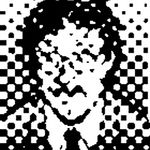Halftone Gradient
Copy link to clipboard
Copied
Can anyone lead me to or answer this problem. I'm doing silk screen printing and need to print gradient halftone images. But when I create these halftone images the black and white dots have their edges fuzzy, they tone out to a grey before going to white background. I've set my radius at 10(small but suitable) and all 4 channels the same degrees, as its one colour(colour black #000000). HOW do I get just black dot and white or transparent backlground without fuzzy gradient edged dots. For those screen printers, I want to do this without rip software.
Thanks Sam
post here of email casa01@telus.net
Explore related tutorials & articles
Copy link to clipboard
Copied
BTW its a gradient MESH halftone.
Copy link to clipboard
Copied
Personally, I would do this in Photoshop.
Since you're already in Illustrator, you need to add this extra step:
After you apply the Color Halftone Effect, change the object's Document Raster Effects Settings to 1200 dpi Greyscale (since it's only one colour, Black). The dots will still be soft-edged, but at that reolution, it will output fine. Chances are you are using a laserprinter that's 600 dpi anyway.
This is good it you are combining these halftone effects with other none-halfoned objects in the same file.
If you are isntead outputting your entire document in halftone, you'd be better off with Photoshop as follows:
Open/render your Illustrator file into Photoshop (again, since it's only Black, open as Greyscale at 300ppi.
Convert it to...
Image > Bitmap > Output:1200 (600 would do, but 1200 has smoother dots)
Method : Halftone Screen.
Click OK and set the screen freq (LPI) you require for silkscreening (probably 30 or less?) and set your angle and shape.
Save as either a Bitmap TIF, or convert back to greyscale 1:1 and save as a PNG.
Copy link to clipboard
Copied
I'm printing to transparent film on an Epson P400 inkjet. Laser's stretch the film. relative to successive film that must match reqistration marks.
Copy link to clipboard
Copied
Either way works.
In fact, Inkjet will be more forgiving. Your dots can only be so crisp with inkjet anyway, but even a tiny bit of anti-aliasing at the edges of the dots will be fine when you expose your photomask.
Copy link to clipboard
Copied
As Brad said, I think this is beast done in Photoshop. Save the Illustrator file normally, then open in Photoshop. Rasterize at 600 ppi, grayscale, antialiassing off. Convert to a bitmap, and here is where you can define the halftone.
If you want you can re-import into Illustrator and replace the gradient mesh. You might need to mask with the mesh’s outline.
Copy link to clipboard
Copied
You could try it with the Rasterize effect, convert to grayscale and rasterize at 300 ppi or even much higher.
Expand the Appearance and use Image Trace to vectorize the halftone screen.
But it may be better to do the halftone screen effect in Photoshop, more choice of and better dot shapes.
Copy link to clipboard
Copied
Agreed, although that does exactly the same as my suggestion, execpt it bakes it in. With my suggestion, the mesh stays live and editable and it ouputs perfectly with crisper dots than the OPs inkjet can print.
Copy link to clipboard
Copied
Thank you Brad for the through explaination. Increasing the DPI solves the delima. But I was wondering if this is the way to always go, as most of the answers zeroed in on the rastered looking edge, and not the fading of the shade along the dots edge.
Sam
Copy link to clipboard
Copied
For what you're doing, it's probably the most achievable without investing in a separate RIP solution.
If you're doing a lot of this, and in multiple colours, RIP is the way to go. A friend of mine uses Accurip for his home-based silkscreen shop and is very happy. I have no experience with it, tho, and I'm sure there are others.
Find more inspiration, events, and resources on the new Adobe Community
Explore Now






